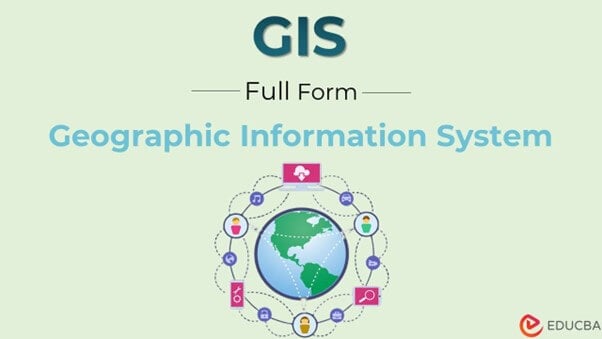Updated June 3, 2023
What is the Full Form of GIS?
The full form of GIS is “Geographic Information Systems.” GIS is a technology that has revolutionized the way you understand and analyze geographical data. GIS combines various databases, hardware, software, and people to create a system for analyzing and visualizing data about the world around us. The system allows organizations to make informed decisions based on accurate, up-to-date information about land use, environmental impact, resource management, urban planning, and much more.
What is GIS and How Does it Work?
GIS is a digital mapping technology that uses digital maps and geospatial data to represent information visually. The digital maps used in GIS are created from satellite imagery, aerial photography, and ground-based survey data. The data is then stored in a database to be analyzed and used to make informed decisions.
GIS software includes tools for data management, data analysis, and map creation. These tools allow you to analyze data to identify patterns, trends, and relationships. It can also answer questions such as “What is the impact of a proposed development on the surrounding area?” or “Where are the areas with the highest concentrations of certain types of land use?”
Benefits of Using GIS
One of the key benefits of using GIS is that it provides organizations with accurate, up-to-date data that can be used to make informed decisions. By analyzing data about the world around us, organizations can identify patterns and trends that would otherwise go unnoticed.
GIS also provides organizations with detailed maps and visualizations that can communicate complex information to stakeholders, including the public, government agencies, and other organizations. These visualizations make it easier to understand complex data and the impact of proposed projects or changes.
In addition, GIS can be used to identify areas at risk for natural disasters such as floods, hurricanes, and earthquakes. This information can help organizations make informed decisions about evacuation plans and disaster relief efforts.
Applications of GIS
After having an idea about the full form of GIS and how it works, let us understand the application of GIS. The following are some GIS applications
1. Land-Use Planning
GIS can analyze land-use patterns, zoning regulations, and demographic data to inform land-use planning and development decisions.
2. Environmental Impact Assessments
GIS can be used to analyze environmental data, such as air and water quality, to assess the impact of proposed projects on the surrounding area.
3. Resource Management
GIS can manage natural resources, such as water, forests, and minerals. This can help organizations make informed decisions about resource allocation and sustainability.
4. Emergency Management
GIS can be used to analyze data about natural disasters, such as hurricanes and earthquakes. This can help organizations make informed decisions about evacuation plans and disaster relief efforts.
5. Transportation Planning:
GIS can analyze transportation data, such as traffic patterns and infrastructure, to inform transportation planning and development decisions.
Growing Importance of GIS in Today’s World
In recent years, the importance of GIS has continued to grow as organizations and individuals become more aware of its potential benefits. The rise of big data and the increasing availability of geospatial data have led to a greater demand for GIS solutions. In addition, the widespread use of mobile devices and the growing popularity of location-based services have further increased GIS’s importance.
GIS has become essential for many organizations, including government agencies, non-profits, and private businesses. It has been used in a wide range of industries, including agriculture, environmental science, urban planning, and transportation, among others.
One of the key factors driving the growth of GIS is the increasing availability of geospatial data. With the rise of big data and the development of the Internet of Things (IoT), organizations can now collect and store vast amounts of data about the world around them. This data can be used to create detailed digital maps that can be analyzed and used to make informed decisions.
Another factor driving the growth of GIS is the increasing popularity of location-based services. With the widespread use of mobile devices and the growing number of location-based apps, people can now access geospatial data in real-time. This has increased the demand for GIS solutions to help organizations and individuals make better decisions based on up-to-date information.
The Future of GIS
The future of GIS looks bright, with many organizations recognizing its potential benefits and the increasing availability of geospatial data. In the coming years, you can expect to see continued growth in the use of GIS in a wide range of industries and the development of new and innovative GIS solutions.
One of the critical areas of growth for GIS in the coming years is machine learning and artificial intelligence. These technologies can revolutionize how GIS is used, making it possible to analyze vast amounts of data and make informed decisions in real-time.
Another area of growth for GIS is likely to be the integration of virtual and augmented reality technologies. This will make it possible to create interactive, immersive experiences that allow users to explore and interact with geospatial data in new and exciting ways.
Conclusion
Geographic Information Systems (GIS) is a powerful technology that has the potential to revolutionize the way we understand and analyze the world around us. With the growing importance of GIS, the increasing availability of geospatial data, and the development of new and innovative solutions, the future of GIS looks bright. Hope this article has helped you understand the full form of GIS and its various facts.
Recommended Articles
We hope that this EDUCBA information on “Full Form of GIS” was beneficial to you. You can view EDUCBA’s recommended articles for more information,



